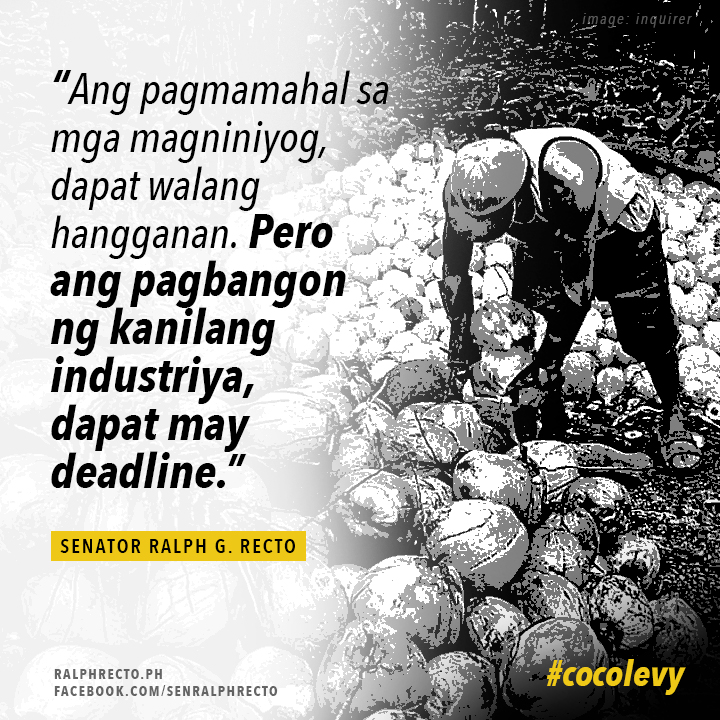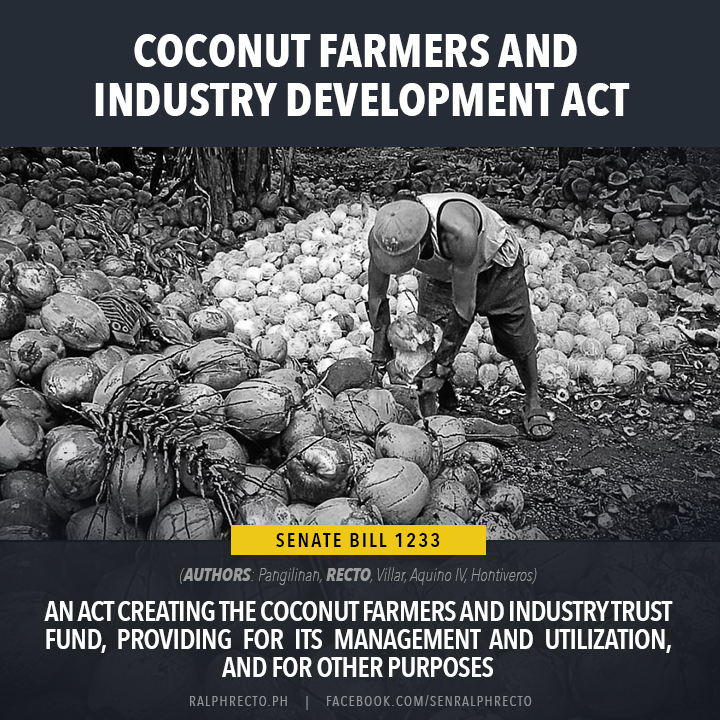Talking Points Part II: Coconut Farmers and Industry Development Act
The last time I stood here, I exhorted us to use, so to speak, our coconuts to drop the perpetual approach in rehabilitating the coconut industry and opt for a faster reconstruction timetable with a fixed deadline.
I said that if an industry is in crisis, efforts to revive it must be quick and massive. If the patient is in ICU, then the treatment must be immediate and in adequate dosage, so that the recovery will be fast.
Naghihingalo na ang industriya, mamamatay na sa uhaw, and we are giving him one tablespoon of water at a time to quench his thirst?
Let me reiterate what I said: Why should we prescribe a drip-drip in funds – magkano ba, 2 to 2.5 billion pesos a year in interest income – on an industry which clearly needs much more.
And, let me remind you, that it is in this Senate’s proud DNA to bring relief in a faster pace to people in need.
When World War II devastated our land, when Pinatubo erupted, our forebears did not authorize a perpetual healing of wounds. They did not comfort our people with this assurance: Help is on the way. It will arrive by installment in 50 years or more.
Gusto ba natin na ang reconstruction ng Marawi ay perpetual? Gusto ba natin na ang pagbangon sa mga nasalanta ng Yolanda ay open-ended at walang katapusan?
Ang pagmamahal sa mga magniniyog, dapat walang hangganan. Pero ang pagbangon ng kanilang industriya, dapat may deadline.
So that is my first point. On a “Do not delay” type of assistance, not the one done in slo-mo.
My second point is to invest the principal and the proceeds in government securities.
I agree with the good chairman, Sen. Cynthia Villar, on adopting a conservative approach in investment.
Mandating that it be plunked in government-issued instruments would rid fund managers of the temptation of investing it in some fancy but high-risk derivatives.
It prevents a fund manager from tempting the odds by placing it in some questionable products.
My third point takes off from the aforesaid principle.
And allow me to provide the context of why I am batting for a simpler management of the trust fund.
I am proud to say that this Senate embraces the idea of a small but smart government.
And in recent months, we have passed bills that cut red tape, and removed the useless and redundant layers of bureaucracy.
We have voted, unanimously, to abolish the Road Board as it is a useless appendage.
In the TRAIN Law, we have shrunk the number of forms, including the tax return, shortened the list of requirements, sped up the process, and slashed the number of times a taxpayer will transact with the BIR.
Last week, we approved, again unanimously, a stronger Anti Red Tape Act that removes—and let me stress this—a number of bureaucratic checkpoints an application for permits and licenses must go through.
We have done so, Mr. President, because we believe that allowing more agencies to regulate and more people to adjudicate reduce not only the velocity of documents being processed, but also their volume.
Thus, any proposal to wrap a program in a layer of oversight is counterintuitive. It is a great leap backward to the age of big government.
When it comes to implementation, the rule that “more hands on board are better” does not work, and is in fact, a prescription for lethargy. It is always the quality of supervisors, and not their quantity, that does the trick.
In the case at hand, the bill already mandates that monies will be invested solely and exclusively in government securities.
If such is the case, then what is the use of creating a very broad trust committee, when the mandate of such has already been restricted? Isa na nga lang po.
I will be the first, however, to concede that we will need a much bigger group of trustees if the menu of investible options is big, so that in deciding where to put the money, the collective wisdom of many minds will help in picking the best option.
Pero sa ngayon isa na nga lang: Government securities. So ano pa ang investment picks na gagawin ng isang committee?
When it comes to where and when to spend the principal and the proceeds of the trust, these will be specified in a master plan that will be drafted with the meaningful participation of coconut farmers.
In short, the spending will be pursuant to a detailed menu. Kung wala sa catalogue of projects and programs, hindi pwedeng gastusin.
Maganda nga at bagay ang terminong ginamit: A roadmap. Made by the farmers, of the farmers, for the farmers. Parang Waze na susundan na lang.
Kung mayroon nang mapa, bakit mo pa kailangan ng isang dosenang driver na magsasabing dito ka kumaliwa, at doon ka naman kumanan?
The spending roadmap is already preordained. It is already inputted. If you have a master document, you don’t need a multitude of navigators.
Ang sunod na tanong: Etsa pwera na ba ang magsasaka? Hindi po. On the contrary, palalakasin natin ang bilang nila sa ahensya na pinakimportante: ang PCA. And this is my fourth point.
Ang PCA ang syang pwedeng tumayong guardian of funds, in addition to its many functions. Ito ang suggestion ko: Dagdagan natin ang bilang ng mga magsasaka sa PCA. Gawin nating supermajority.
From the present 5 gawin nating 6, o pwede pa 11, para doon sa naniniwala sa Noah’s Ark of legislation. Gawin nating majority ang farmers doon. Kung 11 ang magiging board, 6 ang farmer’s representatives—2 each from Luzon, Visayas and Mindanao.
PCA is the Ground Zero of all activities to resuscitate the industry. Let us help the farmers seize the center.
Let us expand, strengthen and broaden its mandate, to include:
First, as the lead initiator, and convenor of the Coconut Industry Roadmap.
Second, empower it with the right to ratify any move to dispose Coco Levy assets. This goes without saying that they, the farmers, will have to be consulted, and their assent secured. Walang sale ng assets, kung wala silang say. The farmer-dominated PCA will, in effect, be vested with veto powers.
Hindi po ba logical, and commonsensical, na we just fuse and fold in the powers of the trust committee into the PCA board, and thus avoid a fragmented, divided body that will oversee the rehabilitation of the coconut industry?
Why maintain two bodies, when, for purposes of efficiency, transparency, accountability and savings, it can be done by one body—the PCA—that is dominated by coconut farmers.
As to the sale of other coco levy assets, my personal position is that in principle, we liquidate them. Ibenta na natin.
As to how, when, to whom, and for how much, let the PCA and the farmer’s representatives therein decide. But such should be done in consultation with the economic managers in order to get the best value for assets to be placed in the auction block.
Sila na ang magtakda ng mekanismo. Ang bottomline: Basta maganda ang presyo, at hindi subasta.
The government’s record in running for-profit businesses has not been embellished with success. What it had left behind are carcasses of state firms plundered of their assets and pillaged of their funds.
At marami pa ngang nangailangan ng bailout. How many billions of pesos were squandered in the lifelines thrown to drowning companies, which eventually sank under the weight of their incompetence?
Let us liquidate these assets, in a manner that is open and fair, no favorites or seeded picks, and make the proceeds part of the trust fund, thereby boosting its portfolio.
Walang kakayahan ang PCA na magpatakbo ng coconut mills at bangko.
At kung i-re-retain natin ang isang trust committee na magde-determine kung ano ang mga kompanyang patatakbuhin, kung saan ilalagak ang pera, kung ano ang investments na gagawin, eh di parang binuhay na rin natin ang omnipotent na CIIF ni Marcos noon.
We’re resurrecting a Marcos-era monopolistic entity, but with a different name.
Lastly po, sa usapin ng appropriations, dalawang punto lang:
Let the government match the trust income with appropriations to the PCA.
Over and above monies to be spent from trust principal and proceeds, I propose that we include a provision setting a minimum of P10 billion budgetary support to coconut farmers.
Pwedeng lagyan po natin ng sunset provision, like 10 years, or we can scale it down after a decade.
Thus, the spending formula is trust income plus appropriations equals coconut development fund.
My second point is my opposition to classify the trust fund as an off-budget item. May pangamba po ako dito kasi yung mga off-budget items natin naperwisyo, nalagay sa peligro.
Exhibit A: Road Users Tax. Exhibit B: Malampaya Fund.
Yung fire fees and firearms fees natin na umabot ng bilyong piso taun-taon, hindi klaro kung saan napunta, dahil outside the reach of congressional scrutiny. They are kept in the dark, placing it out of the reach of sunlight, which they say is the best fund disinfectant.
Even travel tax payments are concealed in the shroud called earmarked revenues, its use annually determined by a group so small that they can caucus inside a van.
Believe me, Mr. President, transparency and off-budget item are not synonymous in our budget lingo.
There are now 155 different laws governing off budget accounts, making them practically hard to track, as placing them outside normal scrutiny distorts the budget process, weakens oversight, loosens expenditure control, and garbles the true picture of resources allotted to an agency.
In its isolated state, an off-budget account can even promote rent-seeking practices, wherein trust control is weak or firewalled from oversight.
Ang posisyon ko: Ilagay sa NEP, for recording purposes, ang itemized na projects and programs of the PCA, based on fund source, whether regular appropriations or trust income.
Let me make my position clear: The fund will remain a trust account; but its usage, reporting and expenditure will follow our budget, accounting, procurement and auditing rules.
Thank you for allowing me to make that manifestation, Mr. President.
RELATED ARTICLES:
-
14 MAR 2018: Postponing barangay polls is strike 3 against grassroots democracy
-
04 OCT 2016: Brgy polls deferment must be the last one – Recto
-
07 SEP 2016: With barangay polls scrapped, how do you endo barangay chairmen who are also drug captains?
-
05 SEP 2016: Senate barangay polls bill to include 2 key reforms
-
28 AUG 2016: Don’t cancel barangay polls without adjusting comelec budget – Recto
-
28 JAN 2015: Poll cancellation will free P7.7 B in SK funds which Recto wants used for child feeding
-
02 AUG 2013: Barangay IRA hiked to P68.3 B next year
SENATE BILLS/AUTHORED LAWS:
-
21 JUL 2016: Senate Bill No. 800: Barangay Officials and Volunteer Workers Social Security Benefits Act of 2016



